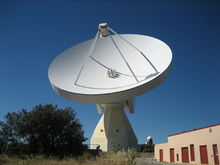Yebes Observatory RT40m
 |
|
| Organisation |
Spanish National Observatory |
|---|---|
| Location(s) |
Yebes |
| Coordinates | 40°31′31″N 3°05′19″W / 40.525208°N 3.088725°WCoordinates: 40°31′31″N 3°05′19″W / 40.525208°N 3.088725°W |
| Altitude | 931 m (3,054 ft) |
| Built | 1999–2007 |
| Telescope style |
Nasmyth telescope |
| Diameter | 40 m (131 ft 3 in) |
| Collecting area | 1,250 m2 (13,500 sq ft) |
| Website | www |
|
|
|
|
[]
|
|
The Yebes Observatory RT40m, or ARIESXXI, is a radio telescope which is part of the observatory at Yebes, Spain. It is a 40-metre Cassegrain–Nasmyth telescope.
The telescope is located at Yebes Observatory (Spanish: Centro Astronómico de Yebes (CAY)). Yebes Observatory is the main scientific and technical facility of the National Geographic Institute of Spain.
The observatory is located around 50 kilometres (31 mi) to the North-East of Madrid in the province of Guadalajara in the autonomous community of Castilla-La Mancha. It sits at an altitude of 931 metres above sea level and enjoys excellent observing conditions year-round. The precipitable water vapour (PWV) level is less than 6 mm and reaches a minimum of 2 mm in the winter. The wind velocity is less than 5 m/s for the majority of the year and the number of days with rain or snow is less than 1 week annually.
The Technological Development Centre (CDT) facilities include two radio telescopes, a solar tower, an astrograph and a Gravimeter. The most powerful telescope is the newly constructed 40 m telescope which was completed in 2005 and saw first light in ¿May 2007?. ARIESXXI was specifically designed to be integrated in the European Very Long Baseline Interferometry network (EVN) as well as operating as a single dish. It currently has active receivers in S-Band (2.2–2.37 GHz), CH-Band (3.22–3.39 GHz), C band which is split in two sub-bands (4.56–5.06 GHz and 5.9–6.9 GHz), X-band (8.15–9.00 GHz) and K-Band (split in four bands between 21.77 and 24.45 GHz). A 100 GHz receiver is currently being installed for millimetre wave VLBI. The CDT has advanced receiver laboratories on site (low-noise amplifiers, quasi-optics etc.) that allows the dedicated team of more than 20 engineers and astronomers present to develop and optimize new and existing receivers. The R&D undertaken in the CDT under the mandate of the OAN permits it to share information and resources with the other important radio observatory in Spain, the IRAM radio telescope at Pico Veleta in Granada. This collaboration also permits the free exchange of ideas and personnel with IRAM's facilities in France and Spain and facilitates technology exchanges between sister institutes in other European countries which participate in the EVN.
...
Wikipedia
